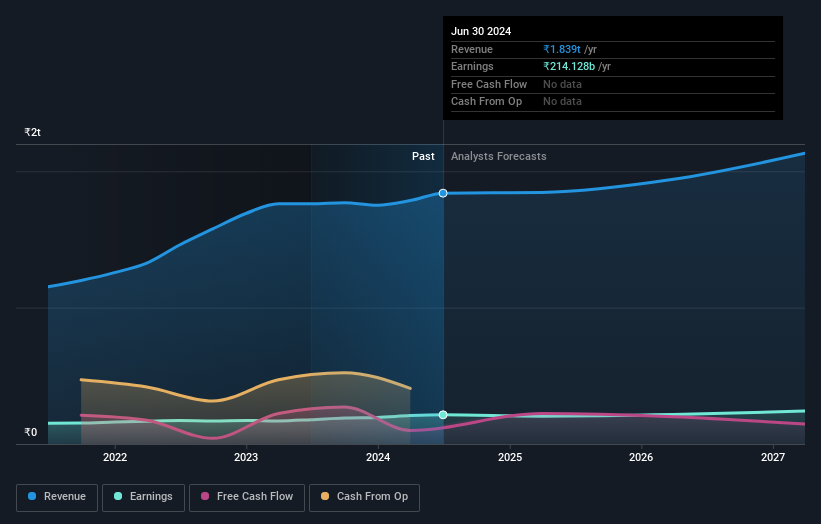- India
- /
- Renewable Energy
- /
- NSEI:NTPC
While institutions invested in NTPC Limited (NSE:NTPC) benefited from last week's 5.6% gain, state or government stood to gain the most
Key Insights
- Significant control over NTPC by state or government implies that the general public has more power to influence management and governance-related decisions
- The largest shareholder of the company is India with a 51% stake
- 35% of NTPC is held by Institutions
To get a sense of who is truly in control of NTPC Limited (NSE:NTPC), it is important to understand the ownership structure of the business. The group holding the most number of shares in the company, around 53% to be precise, is state or government. In other words, the group stands to gain the most (or lose the most) from their investment into the company.
While state or government were the group that benefitted the most from last week’s ₹219b market cap gain, institutions too had a 35% share in those profits.
In the chart below, we zoom in on the different ownership groups of NTPC.
See our latest analysis for NTPC

What Does The Institutional Ownership Tell Us About NTPC?
Many institutions measure their performance against an index that approximates the local market. So they usually pay more attention to companies that are included in major indices.
NTPC already has institutions on the share registry. Indeed, they own a respectable stake in the company. This suggests some credibility amongst professional investors. But we can't rely on that fact alone since institutions make bad investments sometimes, just like everyone does. It is not uncommon to see a big share price drop if two large institutional investors try to sell out of a stock at the same time. So it is worth checking the past earnings trajectory of NTPC, (below). Of course, keep in mind that there are other factors to consider, too.

We note that hedge funds don't have a meaningful investment in NTPC. The company's largest shareholder is India, with ownership of 51%. This essentially means that they have extensive influence, if not outright control, over the future of the corporation. In comparison, the second and third largest shareholders hold about 4.5% and 4.2% of the stock.
While studying institutional ownership for a company can add value to your research, it is also a good practice to research analyst recommendations to get a deeper understand of a stock's expected performance. There are plenty of analysts covering the stock, so it might be worth seeing what they are forecasting, too.
Insider Ownership Of NTPC
The definition of an insider can differ slightly between different countries, but members of the board of directors always count. Management ultimately answers to the board. However, it is not uncommon for managers to be executive board members, especially if they are a founder or the CEO.
I generally consider insider ownership to be a good thing. However, on some occasions it makes it more difficult for other shareholders to hold the board accountable for decisions.
Our most recent data indicates that insiders own less than 1% of NTPC Limited. As it is a large company, we'd only expect insiders to own a small percentage of it. But it's worth noting that they own ₹9.0m worth of shares. In this sort of situation, it can be more interesting to see if those insiders have been buying or selling.
General Public Ownership
The general public-- including retail investors -- own 12% stake in the company, and hence can't easily be ignored. While this size of ownership may not be enough to sway a policy decision in their favour, they can still make a collective impact on company policies.
Next Steps:
It's always worth thinking about the different groups who own shares in a company. But to understand NTPC better, we need to consider many other factors. Take risks for example - NTPC has 2 warning signs (and 1 which is concerning) we think you should know about.
If you would prefer discover what analysts are predicting in terms of future growth, do not miss this free report on analyst forecasts.
NB: Figures in this article are calculated using data from the last twelve months, which refer to the 12-month period ending on the last date of the month the financial statement is dated. This may not be consistent with full year annual report figures.
Valuation is complex, but we're here to simplify it.
Discover if NTPC might be undervalued or overvalued with our detailed analysis, featuring fair value estimates, potential risks, dividends, insider trades, and its financial condition.
Access Free AnalysisHave feedback on this article? Concerned about the content? Get in touch with us directly. Alternatively, email editorial-team (at) simplywallst.com.
This article by Simply Wall St is general in nature. We provide commentary based on historical data and analyst forecasts only using an unbiased methodology and our articles are not intended to be financial advice. It does not constitute a recommendation to buy or sell any stock, and does not take account of your objectives, or your financial situation. We aim to bring you long-term focused analysis driven by fundamental data. Note that our analysis may not factor in the latest price-sensitive company announcements or qualitative material. Simply Wall St has no position in any stocks mentioned.
About NSEI:NTPC
Good value with proven track record and pays a dividend.
Similar Companies
Market Insights
Community Narratives




